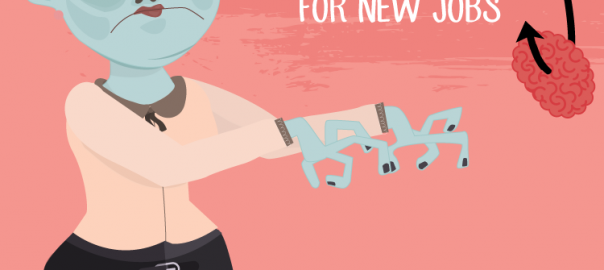Most people reading this probably watch the hit tv show The Walking Dead, with nearly 16 million people tuning in for their season finale.
In case you haven’t seen it before, it’s about an apocalyptic world dominated by zombies. But zombies don’t only exist on TV, they can be found in the workplace too.
Have you ever seen workplace zombies before?
The people that Gallup refers to as “actively disengaged,” the ones that obviously don’t want to be there.
How big of a deal is it to have workplace zombies inside your company?
Add this infographic to your site by copying this code: This infographic was crafted with love by Officevibe, the employee engagement solution that helps engage employees, so they don’t become THE WORKING DEAD.
This infographic was crafted with love by Officevibe, the employee engagement solution that helps engage employees, so they don’t become THE WORKING DEAD.
According to a 2012 Bersin & Associates report, companies spend around $ 720 million on improving employee engagement. They’re spending millions of dollars to improve engagement, but 70 percent of workers are still disengaged. Obviously, something’s not working.
Too many companies are stuck in the past and are too slow (or afraid) to change.
The signs of disengaged employees are somewhat obvious to see. They’re unmotivated and unhappy, but even worse is the fact that they spread that unhappiness to other team members, and ruin the culture that you’re (hopefully) working hard to maintain.
You can use Officevibe’s employee engagement ROI calculator to see just how bad it is for your company.
According to research from Gallup, there is a direct connection between employee engagement and nine performance outcomes:
- customer ratings
- profitability
- productivity
- turnover (for high-turnover and low-turnover organizations)
- safety incidents
- shrinkage (theft)
- absenteeism
- patient safety incidents
- quality (defects)
Let’s go through each of these, one by one and explore them further.
Avoid The Working Dead
Read some tips that will make your office a better place to be at with less zombies and more fun.
Customer Ratings
According to research from Aon Hewitt, teams that had high levels of engagement had a 37% net promoter score (NPS) versus 10% NPS for teams with lower engagement.
Zappos, which is well-known for their company culture has 75% of their purchases coming from repeat customers. The customer experience is so strong, that they’re more than happy to do business with them again. If Zappos’ employees were disengaged, this would never happen.
Profitability
In a study of 23,910 business units comparing top quartile and bottom quartile engagement scores, found that those in the top quartile averaged 12% higher profitability.
It makes financial sense to invest in employee engagement. When employees are engaged, not only will they give better service to customers, but they’ll be more likely to innovate and find better ways of doing what they’re doing.
Gallup estimates that a disengaged employee costs an organization approximately $ 3,400 for every $ 10,000 of salary.
Productivity
Research from Gallup finds that disengaged employees cost the American economy up to $ 350 billion a year due to lost productivity.
If you’re paying employees to be there, naturally you want them to be as productive as possible. As a leader, you should be doing everything you can to ensure they’re productive, like give employees more autonomy over their work.
Turnover
There are very significant costs associated with turnover, with some estimates being as high as 200% of their salary (depends on the position), but there are also a lot of hidden costs, like the time it takes to replace and retrain someone else.
Research from the Corporate Leadership Council shows that Engaged employees are 87% less likely to leave the organization than the disengaged
Safety Incidents
MolsonCoors found that engaged employees were five times less likely than non-engaged employees to have a safety incident and seven times less likely to have a lost-time safety incident.
This is a very serious issue and more than a financial one. The well-being and safety of your employees should be top of mind at all times.
Shrinkage (Theft)
According to an article on Lawyers.com, employee theft costs companies billions of dollars each year, although you probably didn’t need an article to figure that out. More than anything, it’s that malicious attitude that you want to avoid. You want employees that genuinely want to be there with you.
Absenteeism
According to Absenteeism: The Bottom-Line Killer, a publication from Circadian, absenteeism costs roughly $ 3,600 per year for each hourly worker and $ 2,650 each year for salaried employees. The links between disengagement, stress, and wellness are all part of this increased absenteeism.
The links between disengagement, stress, and wellness are all part of this increased absenteeism.
Patient Safety Incidents
The Gallup research shows that work units in the top quartiles of engagement have 41% fewer patient safety incidents, which is incredible. Disengaged employees simply don’t care as much about their work, so of course they’re more prone to making mistakes.
Quality (defects)
In a report from Development Dimensions International, they found that an Unnamed Fortune 100 manufacturing company reduced quality errors from 5,658 parts per million to 52 parts per million by focusing on engagement.
Actively disengaged employees (or workplace zombies) are not putting in the same amount of effort to make sure they deliver a quality product or service, which is having major effects on your customers.
Science-Based Ways To Improve Engagement
There are many ways to improve employee engagement, and most of the ideas are free. You can be creative in how you try and increase it, but here are a few ways that you can improve engagement and make employees happier, backed by science.
Tell Employees To Time-box Their Tasks
The mind can only focus on so much for so long without getting tired, so you should do what’s called time-boxing, where you only work on one task for a set period of time.
In a study done in 2001, researchers found that participants lost significant amounts of time as they switched between multiple tasks and lost even more time as the tasks became increasingly complex.
According to the researcher:
productivity can be reduced by as much as 40 percent by the mental blocks created when people switch tasks.
Encourage Employees To Exercise
One study found that exercise seems to be the most effective mood-regulating behavior, because of the releasing of endorphins.
The key here is exercising regularly, and not necessarily the intensity or length of the workout itself.
Have Walking Meetings
A University of Michigan study found that people who spent time outside were better able to solve creative problems.
Researchers split the group in two, and asked them both to solve a series of problems. The group that had spent time outside, were able to respond much more accurately.
Recently, researchers at Stanford University tested creativity in people that were walking vs. sitting. What they found was that the majority of people were more creative when they were walking. They found that creativity improved by an average of 60% when the person was walking.
Put simply, focus on employees’ health, wellness, and happiness, and your company can avoid the disengagement plague and not have to deal with … The working dead.
Speaking Of Zombies…
We recently took over TechCrunch’s Montreal pitch-off, as we came in decked out in full zombie attire. You might have seen the pictures on the internet or on our Facebook Album
We made quite the splash, as people from all across North America came together to talk about new applications that will change the world. We had great competition and won the fan vote and ended up coming in second place; which has gives us free entry to TechCrunch Disrupt.
So we wanted to thank all the people who follow our blog and our users out there who have helped us grow a wonderful product and company. We hope to change even more workplaces within the coming years.
We’d also like to apologize to Jordan from TechCrunch, for scaring her with our zombie getups. The message of our pitch and product is clear: If we don’t change the way we work, we’re going to end up disengaged, stressed, and living difficult lives, as we can’t enjoy ourselves.
Here’s our TechCrunch Pitch, we hope you enjoy it. And please feel free to make fun of Daniel’s French-Canadian accent.
Do You Fear The Working Dead?
Do you see a lot of actively disengaged employees within your office? Let us hear some horror stories and tweet us @officevibe
Here’s the link to the Bersin study mentioned.
(262)
Report Post





